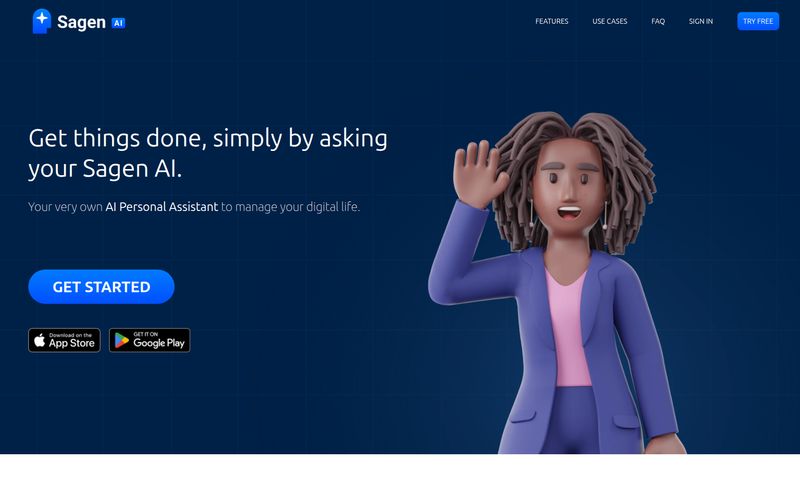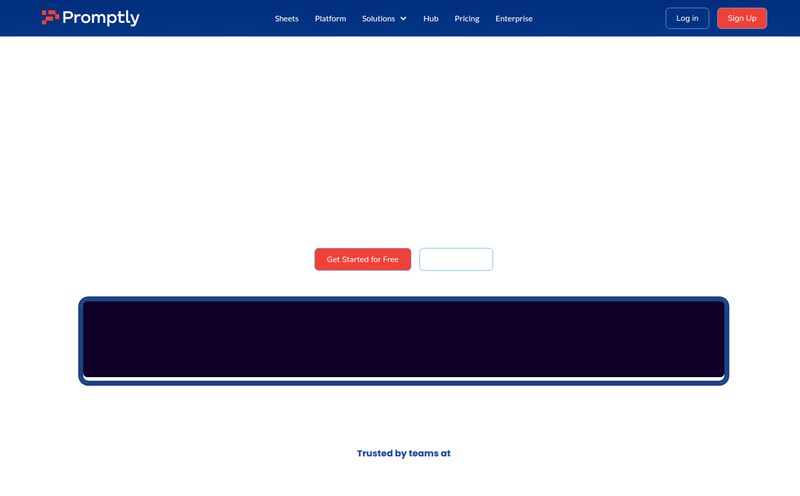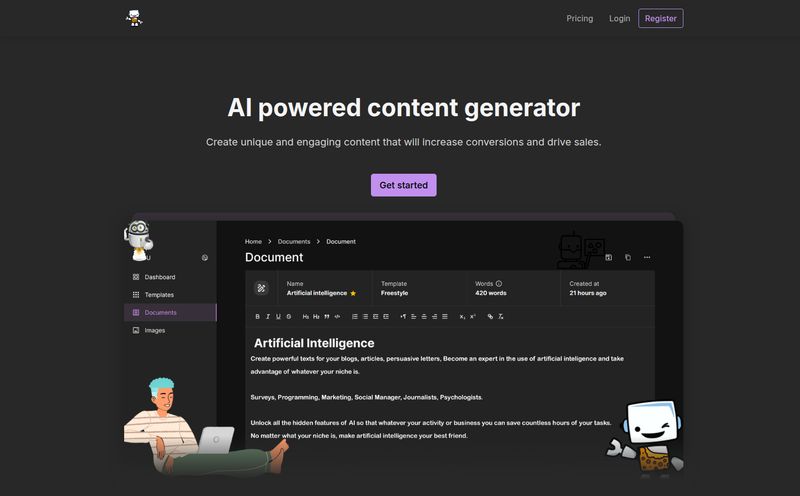I spend an unhealthy amount of my day wrangling content. Seriously. Whether it's for SEO, trend spotting, or just trying to keep up with the firehose of information that is the modern internet, I'm always looking for a better way to funnel it all into something manageable. For years, my trusty sidekick was RSS. Good old, reliable, simple syndication. But let's be honest, RSS has been on life support for a while. So many modern sites don't even bother with a feed anymore.
Then the AI boom happened. Suddenly, it wasn't just me trying to read the web; it was Large Language Models (LLMs) that needed to be fed a constant, clean diet of high-quality information. The problem is, the web is a messy, chaotic buffet. Not exactly the clean, structured data an AI needs to learn without getting digital indigestion.
So, you can imagine my curiosity when I stumbled across a tool called FeedPo. The headline on their site is bold: “AI-First Feed Generate Service. Turn any web content into LLM-Ready feeds in a simple way.”
Okay, you have my attention. Is this the missing link between the wild, unstructured web and the structured appetites of our new AI overlords? And more selfishly, could it bring my beloved RSS back from the dead? Let's find out.
So, What on Earth is FeedPo?
Think of FeedPo as a universal translator for websites. You point it at a URL—any URL, theoretically—and it acts like a super-smart scraper. But instead of just dumping a pile of jumbled HTML on your lap, it intelligently figures out what the main content is (the article, the product details, etc.) and then repackages it neatly into a structured format.
The name itself is a clue: Feed Portal. It's creating a clean doorway to the content. The homepage says it can output this structured data in a few key flavors:
- LLM-Ready Feeds: This is the big one for the AI crowd. It's essentially content that has been cleaned, stripped of junk like ads and sidebars, and formatted in a way that’s easy for a machine learning model to ingest.
- JSON Feeds: A developer's favorite. It’s a lightweight, easy-to-parse format that’s perfect for plugging into other applications.
- Markdown: A simple text format that preserves basic styling. Great for documentation or creating clean versions of articles.
- RSS Feeds: Hallelujah! For those of us who still live and breathe by our feed readers, this is a godsend. It can generate a classic RSS feed for sites that have abandoned them.
It’s like having a personal chef for web content. The internet is a messy, chaotic kitchen full of raw ingredients, and FeedPo is the mise en place cook who chops, sorts, and preps everything, so the master chef (you, or your AI) can get right to work. It’s a pretty compelling idea.
Who Is This Actually Built For?
When I first looked at it, I saw a few clear groups of people who would be jumping up and down for a tool like this. It's not just for one niche, which I find really interesting.
The AI Agent and LLM Builders
This is FeedPo's main pitch. If you're building an AI agent that needs to stay current with information from a specific website, you can't just let it browse the web like a person. It's inefficient and prone to errors. Instead, you could use FeedPo to create a clean, dynamic feed from that site. The AI agent then just has to read the feed, which is way faster and more reliable.
It's also a huge deal for anyone working with Retrieval-Augmented Generation (RAG). That’s a fancy term for giving an LLM access to external, up-to-date information so it doesn't just rely on its old training data. FeedPo could be the tool that creates and maintains that external knowledge base automatically. That's a big deal.
The SEOs and Content Curators
You know who you are. We're the ones with 50 tabs open, monitoring competitors, tracking industry news, and looking for content to share. Imagine being able to create a custom feed of your top 10 competitors' blogs, all in one place. Or a feed of a specific product category on an e-commerce site that doesn’t have an API.
It turns the web into your personal, queryable database. For competitive analysis and content monitoring, the applications are pretty obvious and powerful. No more manual checking day after day. Just check your feed.
The Glorious Return of the RSS Feed
I can't be the only one who misses the old days. I still use Feedly every single day, and it drives me crazy when a cool new blog or news site I find is built on some fancy JavaScript framework with no RSS feed in sight. Tools like FeedPo are a direct solution to that. You can resurrect the feed for any site you want to follow. It’s a simple, almost nostalgic use case, but for a certain type of internet power user, its a game changer.
The Experience and First Impressions
Alright, so the concept is solid. But what’s it like to use? The site itself is incredibly minimalist. There’s no fluff, just a headline and a few sentences of explanation. I appreciate that. No marketing nonsense, just get to the point.
I did notice something that tells me this tool is probably very new, or maybe a passion project. When I clicked on a couple of the blog links in the footer, I hit a 404 - Page Not Found. Now, some might see that as a red flag. Me? I kinda get excited. It feels like I've found something in its early stages, a diamond in the rough before it gets all polished and corporate. It suggests the developers are focused on the core tech first, and the website trimmings second. I can respect that.
Based on the description, the process seems straightforward: you give it a URL, it does its AI magic, and you get a link to your shiny new feed. However, one of the 'cons' I found in the info I gathered was that it "may require some configuration to ensure accurate content extraction." This is the reality of web scraping. Sometimes you have to give the tool a little hint, like telling it which `
The Good, The Bad, and The Scrappy
Every tool has its trade-offs. From what I can gather, here's the breakdown for FeedPo.
The clear advantage is the automation and the focus on creating genuinely useful, AI-ready data. Many scrapers just give you raw data; FeedPo's goal is to give you intelligence. Supporting multiple formats like JSON, Markdown, and the all-important RSS is a massive plus, making it incredibly versatile. For anyone without deep coding skills who wants to do what used to require Python and libraries like BeautifulSoup, this could be a fantastic shortcut.
On the flip side, the tool's effectiveness is tied to the structure of the source website. A well-structured, semantic HTML site will probably work perfectly. A messy, tag-soup nightmare of a site from 2005? Maybe not so much. This isn't really FeedPo's fault—it's the nature of the web—but it's something to be aware of. You might have to do some tinkering to get the perfect result every time.
What's the Deal with Pricing?
This is the million-dollar question, isn't it? As of my writing this, there's no pricing page on the FeedPo site. Zilch. Nada. This, combined with the 404s, reinforces my theory that this is a very new service. Often, this means a few things: it could be in a free beta period, it might be invite-only for now, or the creators are still hammering out a pricing model. For now, we'll have to wait and see. I'm hoping for a generous free tier for us RSS diehards!
Frequently Asked Questions about FeedPo
What is an LLM-ready feed?
Think of it as a pre-digested meal for an AI. It's a data feed where the core content of a webpage (like an article or product info) has been isolated from all the noise (ads, navigation, footers) and structured in a clean, consistent format that a machine can easily read and understand without confusion.
Can I use FeedPo to create an RSS feed for any website?
Theoretically, yes. The goal is to work on any URL. However, its success will depend on how the target website is built. Extremely complex, JavaScript-heavy sites might pose more of a challenge than a simple blog post, but it's designed to handle a wide variety of web structures.
Is FeedPo difficult to set up?
The premise is simplicity. While some complex sites might require a bit of configuration to help the tool identify the correct content, the basic operation is designed to be as simple as pasting a URL. It's meant to be more user-friendly than writing a custom scraping script.
How does FeedPo handle dynamic websites?
This is a key technical question. Many modern scrapers have to render JavaScript to see the final content. An "AI-First" service like FeedPo likely uses advanced techniques, possibly a headless browser on the backend, to interpret these dynamic sites and extract the content as a user would see it.
Is FeedPo free?
Currently, there is no public pricing information available. The service appears to be very new, so it might be in a free beta phase or an early-stage launch. It's best to check their website for the most current information.
Final Thoughts: Is FeedPo a Glimpse of the Future?
I get excited by tools that don't just solve an old problem, but solve it in a way that anticipates a new one. FeedPo feels like that. It's solving the age-old problem of web scraping and content aggregation, but with a keen eye on the massive, growing need for clean data to power the AI revolution.
It’s a bridge between two eras of the internet: the human-readable web and the new machine-readable web. While it seems to be in its infancy, the promise is enormous. If the team behind it can nail the execution and make that configuration process painless, FeedPo could become an indispensable tool for developers, marketers, researchers, and anyone else trying to make sense of the beautiful chaos of the web.
I, for one, will be keeping a very close eye on it. And creating a whole lot of RSS feeds in the meantime.
Reference and Sources
- FeedPo Official Website: https://feedpo.com/
- About Retrieval-Augmented Generation (RAG): Amazon Web Services
- An Alternative RSS Generator: RSS.app



